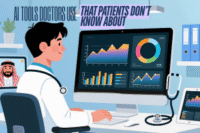Analytics- Turning Data into Smart Decisions
Published: 25 Apr 2025
In today’s digital landscape, Analytics isn’t just a buzzword’s a core driver of smart decisions. Whether you’re a student exploring career options, a small business owner trying to optimize operations, or a marketing professional aiming to fine-tune campaigns, understanding how data works is critical. Analytics is the systematic process of collecting, analyzing, and interpreting data to extract meaningful insights that help recognize patterns, identify trends, and make informed decisions.
From platforms like Google Analytics, Firebase, and Power BI, to simple tools like Excel, raw data can be transformed into real-world strategies. Analytics empowers organizations to improve outcomes and enables students and professionals to gain in-demand skills for the modern workforce.
What Is Analytics?
Analytics is like a compass in a sea of data—guiding businesses toward the right decisions. Just as a compass provides direction, analytics brings clarity amidst the chaos of information, particularly in critical areas like cybersecurity for small businesses.

Key Highlights
- Definition: Study and interpretation of data to generate insights.
- Core Function: Identifies trends and supports strategic decisions.
- Key Tools: Google Analytics, Firebase, Excel, Tableau, Python.
Industry-Specific Use Cases of Analytics
Analytics help us monitor the details about many things like:
Business
Tracks website traffic, monitors conversion rates, and improves engagement using Google Analytics and dashboards.
Healthcare
Uses predictive analytics to forecast patient outcomes and allocate resources effectively.
Human Resources
Applies analytics in talent acquisition, performance tracking, and predicting workforce behavior.
Marketing
Platforms like YouTube Analytics and Instagram Insights help marketers monitor campaign effectiveness and user behavior.
Why Analytics Matters
Analytics plays a critical role in enabling data-driven decision-making, streamlining processes, and uncovering future opportunities.
Key Benefits
- Informed Decisions: Solid foundation for strategic planning.
- Process Optimization: Highlights inefficiencies and maximizes resource usage.
- Fuels Innovation: Supports development through platforms like Firebase, Power BI.
Real Experience- How Analytics Changed My Freelance Marketing Career
When I started freelance digital marketing, I relied heavily on gut instincts. Once I integrated Google Analytics into my workflow, everything changed. I learned what content worked, which audiences converted, and how users interacted with landing pages. This data didn’t just inform-it transformed my approach. Within months, I increased my client conversion rate by 40%, simply by making decisions rooted in data.
The Future of Analytics
As organizations digitize, analytics will become more personalized and intelligent. Tools like Google Analytics 4, AI dashboards, and custom APIs offer real-time, granular insights.

For Students: Why You Should Learn Analytics
If you’re aged 16+, interested in technology, business, or marketing, mastering analytics tools will unlock doors to careers in business intelligence, software development, or data analysis.
Recommended Learning Paths
- Google Analytics Academy (free courses + certification)
- Internships in digital marketing or business analytics
- Courses on Udemy, Coursera, or DataCamp
How Analytics Works
Step-by-Step Breakdown
- Data Collection
Tools: Google Analytics, Firebase, etc. - Data Cleaning
Removes inconsistencies and prepares it for processing. - Analysis
Uses machine learning and statistical models. - Visualization
Dashboards (like Analytics Hub, Zoho) make it easier to interpret results. - Decision-Making
Insights are translated into smart strategies.
Common Misconceptions
- Myth: Only large companies need analytics.
Truth: Even SMBs benefit from tools like Zoho Analytics. - Myth: Analytics is only for coders.
Truth: It requires logic and interpretation-skills anyone can develop.
Types of Analytics
- Descriptive Analytics: Understand past data trends
- Predictive Analytics: Forecast future outcomes
- Prescriptive Analytics: Recommend actions
- Diagnostic Analytics: Explain “why” something happened
Personal Experience: Learning Analytics as a Student
During college, I volunteered to help a startup manage their marketing. With zero experience, I learned Google Analytics through its free academy. I presented weekly reports that showed bounce rates and traffic behavior-insights that impressed the CEO and helped shape their product launch strategy. That small internship opened the door to my first full-time job.
User-Focused Use Cases
- Business Owners: Track web traffic, conversions
- Marketers: Optimize campaign ROI
- HR Professionals: Manage and predict workforce performance
Applications of Analytics Across Industries
- Business: Track behavior and conversions
- Marketing: Enhance targeting with Google Ads
- Healthcare: Forecast patient needs
- Retail: Personalize shopping via Firebase
- Education: Optimize student outcomes
Niche Focus: Analytics in Marketing
Marketers using YouTube Analytics and Google Ads can track click-through rates, identify audience behavior, and increase ROI through data segmentation.
Advantages and Disadvantages
| Advantages |
|---|
|
| Disadvantages |
|---|
|
Conclusion:
In today’s digital age, analytics isn’t just a tool-it’s a mindset. Whether you’re a student aiming to stand out, a marketer tracking campaign success, or a small business owner making smarter moves, analytics helps you understand what truly works.
From platforms like Google Analytics and Firebase to visualization tools like Power BI and Tableau, you can turn numbers into smart decisions. I’ve personally seen how analytics transformed a failing project into a high-performing success, simply by understanding what the data was trying to tell us.
FAQs
No, you don’t need coding to get started. Many tools like Google Analytics, Excel, and Power BI are user-friendly and designed for beginners.
Analytics focuses on interpreting data to make decisions, while data science involves creating models and algorithms to predict or automate outcomes. Think of analytics as reading data, and data science as building with it.
You can start with free platforms like Google Analytics Academy or YouTube’s Creator Studio. Try analyzing data from your own blog, social media, or school projects.
Start with Excel or Google Sheets for basic data handling, and then try Google Analytics or Power BI for dashboards and visualizations.
If you dedicate a few hours weekly, you can grasp the basics in 1–2 months. Building advanced skills can take longer, but it’s a steady, rewarding process.
Jobs in marketing, business intelligence, software, finance, and even healthcare rely on analytics to make decisions and improve results.
From tracking your fitness app stats to monitoring views on your YouTube videos, analytics helps you understand patterns and improve what you do.
Not at all! Small businesses and even individuals can use analytics to improve websites, plan content, or boost sales.
You can clean and verify the data using basic tools or double-check with multiple sources. It’s a normal part of the analytics process.
Yes! Tools like Google Analytics are free and easy to integrate into websites, even if you’re using WordPress, Blogger, or a custom domain.

- Be Respectful
- Stay Relevant
- Stay Positive
- True Feedback
- Encourage Discussion
- Avoid Spamming
- No Fake News
- Don't Copy-Paste
- No Personal Attacks

- Be Respectful
- Stay Relevant
- Stay Positive
- True Feedback
- Encourage Discussion
- Avoid Spamming
- No Fake News
- Don't Copy-Paste
- No Personal Attacks





